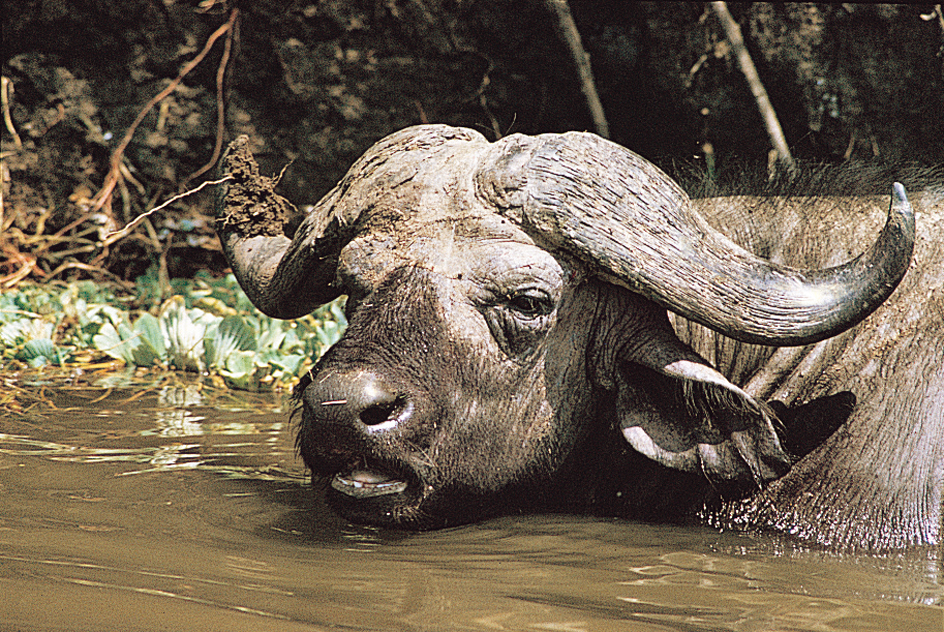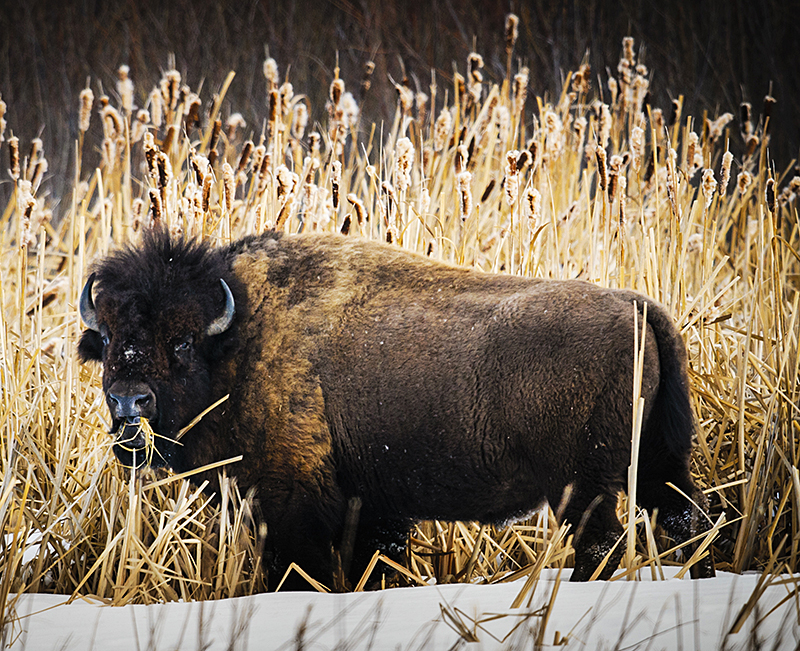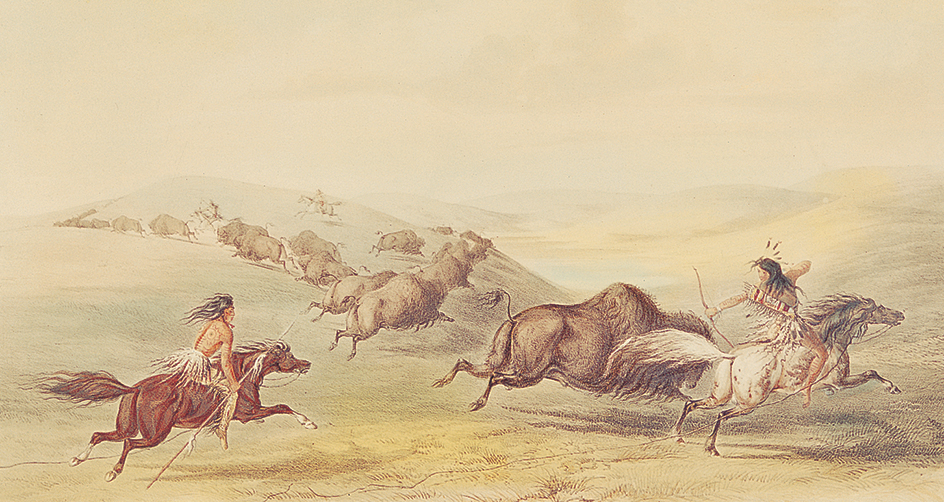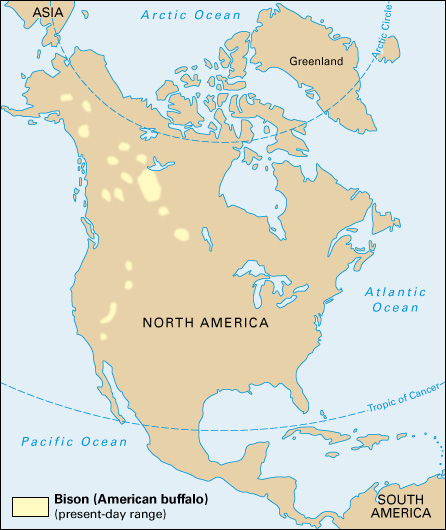Buffalo is the common name of several kinds of large wild oxen. The name was first given to the black water buffalo of India. This large animal was so named because it likes to soak itself in pools of water for hours at a time. In its wild state, the water buffalo can be dangerous. Wild water buffaloes have become scarce because people have hunted them and cleared their forest habitats for farmland. Domestic (tame) water buffaloes are used as beasts of burden in most of the warmer parts of Asia and Africa. The carabao is a small Philippine variety of domestic water buffalo. See Water buffalo.
Loading the player...Herd of grazing buffalo
A wild black buffalo, called the tamarau, lives in dense forests on the Philippine island of Mindoro. This small buffalo stands only 31/2 feet (107 centimeters) high. The anoa, a still smaller forest buffalo, lives on the Indonesian island of Sulawesi. These animals are quite rare and are classified as endangered species.
Wild buffaloes also live in Africa. The Cape buffalo of South Africa is a large, black animal with nearly as bad a temper as that of the Indian buffalo. It resembles the Indian buffalo in many of its habits, but has never been tamed. Another wild buffalo, related to the Cape buffalo, lives in forested regions in western and central Africa. One form of this buffalo lives in the Congo region. Like the tamarau, it stands only 31/2 feet (107 centimeters) high.

American buffalo, or bison.
Most Americans know this large wild animal simply as “buffalo.” But zoologists do not consider it a true buffalo. They call it a bison. Unlike the buffaloes already described, it has a large head and neck and humped shoulders. It also has 14 pair of ribs, instead of the 13 pair found in true buffaloes.

The American bison, or “buffalo,” is brownish-black, except on the hind part of the body, which is brown. Long, coarse hair covers the head, neck, and hump. The hair forms a beard on the throat and chin. The head has a pair of horns like those of domestic cattle. Some pairs of horns spread 35 inches (89 centimeters) at their widest point. A full-grown bull (male) measures from 10 to 121/2 feet (3 to 3.8 meters) long, from the tip of his nose to the end of his short, tufted tail. His height at the shoulders measures from 51/2 to 6 feet (1.7 to 1.8 meters). Bulls usually weigh from 1,600 to 2,000 pounds (726 to 910 kilograms). Extremely large ones may weigh as much as 3,000 pounds (1,400 kilograms). Cows (females) are much smaller than bulls and rarely weigh more than 900 pounds (410 kilograms).
Great herds of bison once roamed over North America between the Appalachian Mountains on the east and the Rockies on the west. Indians depended upon bison flesh for food and bison hides for clothing. In 1850, about 20 million bison still thundered over the western plains. Huge herds often forced railroad trains to stop while the animals crossed the tracks. In the late 1800’s, white American hunters slaughtered millions of bison. This killing deprived the Indians of their main source of food and almost wiped out the bison.

Protection of bison.
By 1889, fewer than 1,000 bison could be found alive in the United States. Then efforts started to prevent the whole species from becoming extinct. William Temple Hornaday, an American zoologist, did much to protect and increase the herds. Game laws and other protective measures allowed the surviving American bison to live and multiply. As a result, about 10,000 bison now live in national, state, and local preserves in the United States. About 3,000 bison roam on public lands in Canada. Most of these animals live in the immense Wood Buffalo National Park, south of Great Slave Lake, and in the Elk Island National Park, near Edmonton. In addition, there are more than 300,000 bison on private ranches throughout the United States and Canada.

Bison are social animals and live in herds. The bulls and the cows graze together throughout the year. A single yellowish-red calf is born in May or June. The bull that leads the herd helps mother cows defend their calves from enemies.
Bison mate when they are 3 years old, but they do not become full-grown for another five years. In rare case, they may live to be 30 or even 40 years old. Their quick tempers have made it impossible to train the animals in captivity.
Bison feed mostly on grass. They also eat a few other small plants, as well as twigs of willows and low shrubs. Some animal breeders have crossed American bison with ordinary domestic cattle. The resulting beefaloes and cattaloes feed on grass and do not require the costly grain feeding needed to fatten cattle.
A cousin of the American bison, called the wisent, was once numerous in Europe. But by the early 1900’s, few of these animals remained. Programs involving the breeding of captive wisents saved the animal from extinction. About 2,000 animals roam in forests in Belarus, Lithuania, Poland, Russia, and Ukraine. The wisent’s head is smaller and carried higher than that of the American bison.
See also Buffalo ceremonials; Indigenous peoples of the Americas (Peoples of the Plains); Water buffalo .
